A Private Tour today, with a difference. It was to be an early start, a full day ranging widely up and down the coast, with a particular list of target birds to go after. We had to be flexible too – as anything can happen! Thankfully, the weather was kind to us – sunny in the morning, cloudier but dry in the afternoon, with light winds.
As we set off from the meeting point, a Barn Owl was still out hunting and flew across one of the fields by the road as we passed. A good way to start the day, with that being one of the species we were after. A little further on, and a Fieldfare flew over – another one we wanted to see today.
The first part of the morning was to be spent looking for gulls. In particular, we were hoping to catch up with one of the Iceland or Glaucous Gulls which have been along the coast in the last week. They have been very mobile though, some may even have moved on already, and we knew it would be a real challenge to find them today. Still, nothing ventured.
On our way down to the coast, we took a quick detour via Felbrigg Park. As we drove in along the access road, we spotted some thrushes in the small trees out in the grass. As well as a couple of Redwings, which flew off as we got out of the car, we managed to get two Fieldfares in the scope, better views than we had of the flyover on our way here.
Then it was on to the beach at Cromer. As we walked up to the clifftop, it was immediately clear there were not many gulls here today. A quick scan of the sea did produce a Shag swimming past just offshore though, quite a scarce bird here and a welcome surprise.

There are sometimes more gulls on the beach the other side of the pier, so we walked down to that end of the prom for a closer look. There were some gulls here, but just Great Black-backed, Herring and Black-headed Gulls, not what we were looking for. We decided to head back to the car and try our luck further east along the coast.
Back on the clifftop, we continued to scan the sea. We spotted a Fulmar flying past offshore and watched as it circled up and came in towards the top of the cliffs. It joined three more Fulmars we hadn’t noticed before, a short distance away to the west of us, which were flying in and out of the sandy cliff face, presumably prospecting for potential nest sites.
Our next stop was along the coast at Mundesley. There had been a Glaucous Gull here earlier in the year, although it has become more elusive recently and has not been seen for a few days. Again, we started by walking over to the top of the cliffs and scanning the sea below. There were a lot more gulls here, which at least gave us something to work through. We had checked out quite a lot of them to no avail and we were looking quiet a long way back to the north when we picked up a juvenile gull on the sea with very pale wing tips. It seemed to have long pointed wings and looked good for an Iceland Gull, one of our targets.
It was a long way off from here, so we followed the path down the cliffs and set off along the beach. Fortunately, when we got there, the gull we had been watching was still present and we could confirm it was indeed a juvenile Iceland Gull. We had a good look at it through the scope, swimming round, before it tucked its head in and went to sleep. We could see its long wings, paler than the rest of its body, and its bill which appeared mostly dark from a distance but close up could be seen to have a diffuse pale base.
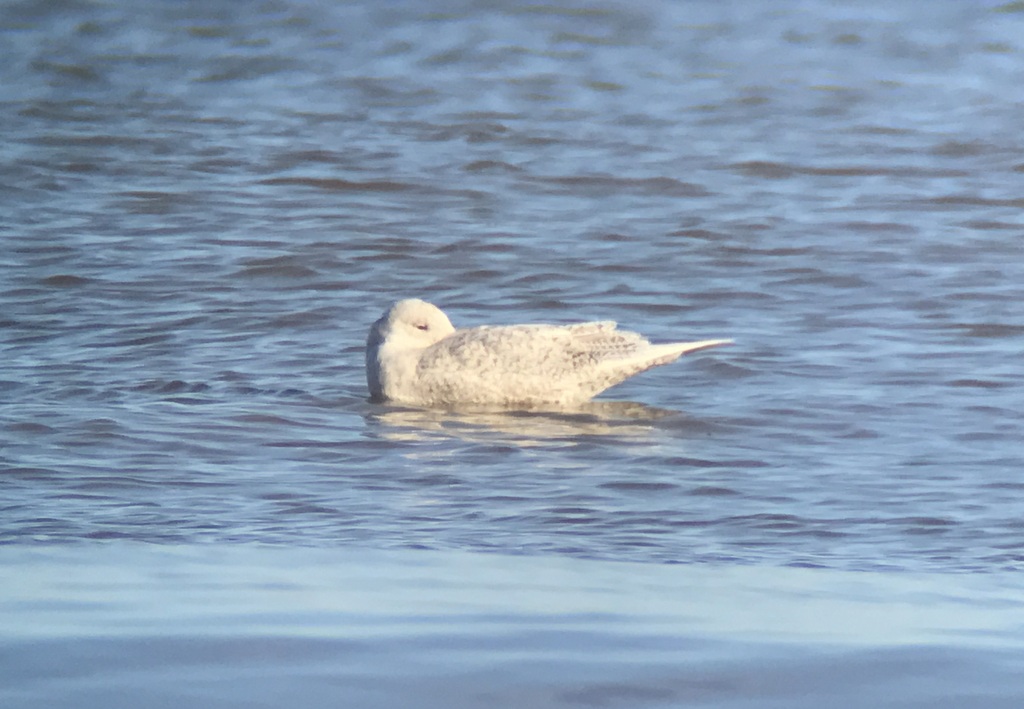
We had a good scan of the rest of the gulls out on the sea as we walked back to the steps, but could not find anything else of note. We did manage to spot a Guillemot out on the sea and three Red-throated Divers flying past in the distance. A Grey Plover and a Sanderling flew along the shore. As we climbed back up the cliffs, a Stonechat landed on a bush not far from the steps.
It was still early, so we decided to have a short drive further down the coast to Walcott. Gulls have sometimes been seen on the groynes here, but when we arrived there were just a few Herring Gulls there. However, as we got out of the car, several pipits flew up from the stubble field on the other side of the road. They sounded mostly like Meadow Pipits, but a couple of them flew towards some wires which spanned the middle of the field.
As we watched the pipits, they joined another bird which was already on the wires. It looked a different shape – plumper, with a more rounded head and shorter bill. A quick look through the scope and we could see it was actually a Lapland Bunting, not what we were expecting here! It appeared to be singing too.

Through the scope, we could see the Lapland Bunting‘s rusty nape and the black outline to its ear coverts and bib. They are scarce winter visitors here, but can sometimes be found in fields around the coast. Stubble fields are often a particular favourite.
Making our way back along the coast, we stopped at West Runton. There has been a large roost of gulls over high tide on one of the ploughed fields here, but there was no sign of any gull there today. A flock of about twenty Brent Geese flew east offshore, presumably heading off back to the continent. The sea was in already when we walked down to the beach, and there were next to no gulls here either. A little flock of Redshank and Knot, accompanied by a single Dunlin, was feeding on the water’s edge but flew off ahead of the rising tide.
Purple Sandpiper was on the target list, so we made our way over to Sheringham next. As we walked along the prom, we could see lots of Turnstones picking around on the shingle or perched on the rocks. There were a few more gulls here, but nothing we hadn’t seen already, apart from better views of several Common Gull.
On the rocky sea defences below the Funky Mackerel cafe, feeding unobtrusively and very well camouflaged apart from its bright yellow-orange legs and bill base, was a Purple Sandpiper. It was beautifully lit and almost looked purple, but was perhaps more subtle shades of grey.
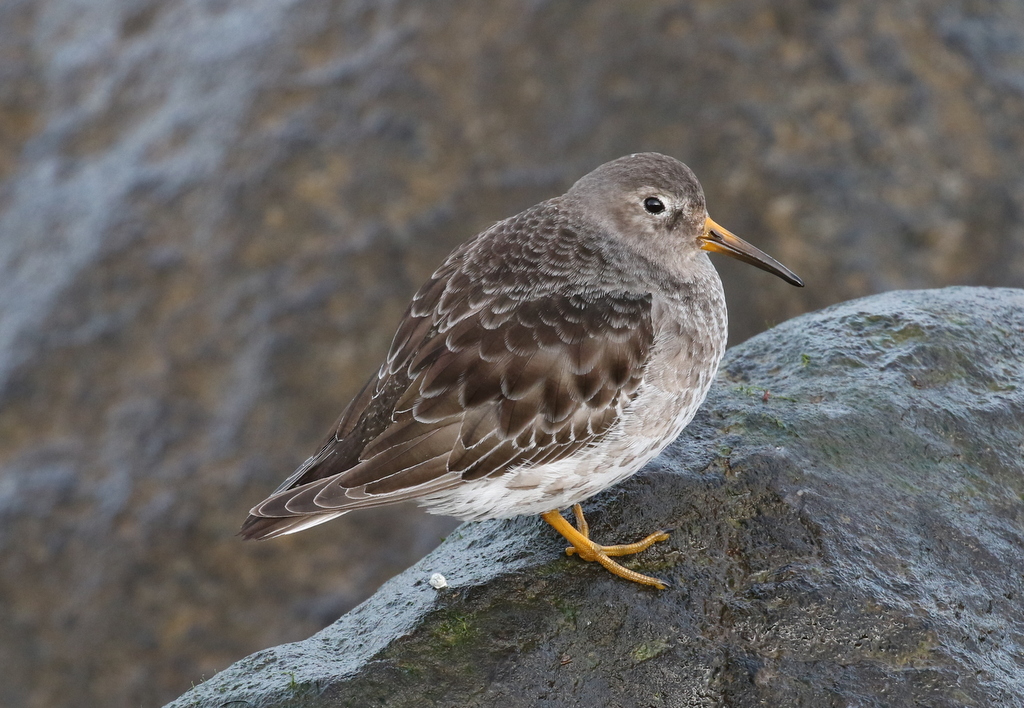
Purple Sandpipers are great birds, full of character. We watched as this one shuffled around or clambered up and down the boulders. It was picking at the algae growing on the face of the rocks.
We walked down to the far end of the prom. A distant Gannet flying past offshore was the only other bird of note, but it was nice to see another two Fulmar‘s prospecting the cliffs here and they gave us a nice fly by as they continued on west. A Rock Pipit flew past calling and we looked up to see a Common Buzzard circling high over the town – possibly a bird on the move already.
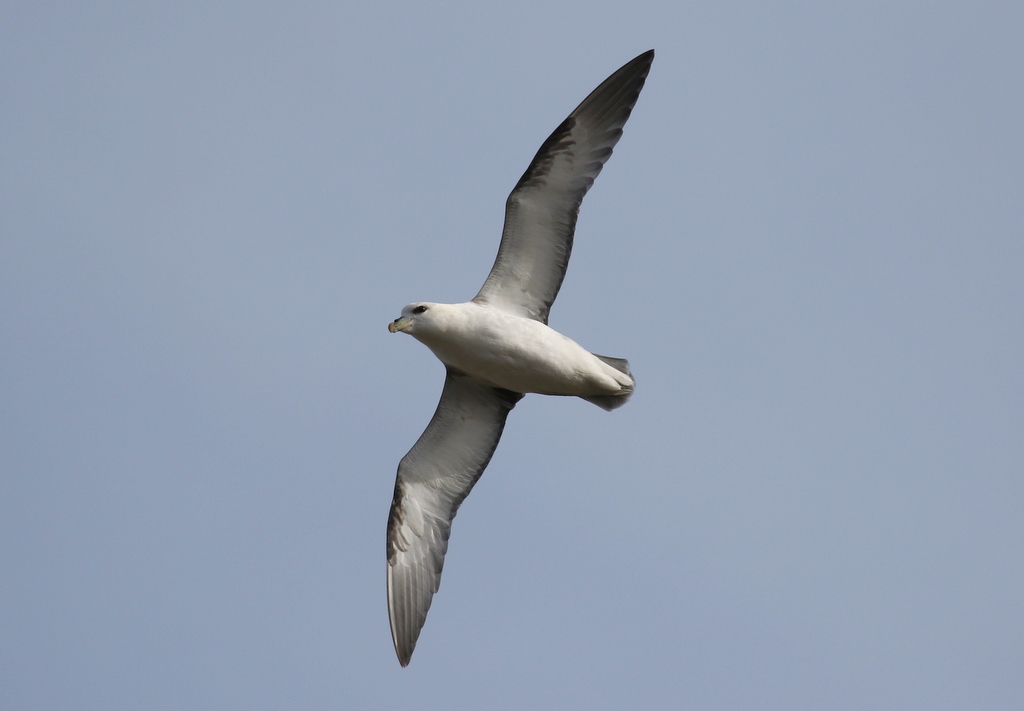
The immediate possibilities for gulls along the coast here were just about exhausted, so we decided to change tack and look for some other birds now. As we continued on our way west, a quick stop by Walsey Hills added three Little Grebes and a Common Pochard on Snipe’s Marsh. There were lots of Brent Geese out on the grazing marshes opposite, but no sign of the Black Brant with them today. A drake Pintail was swimming down one of the channels.
When we got to Holkham, we decided to stop for an early lunch. There were lots of Wigeon out on the grazing marshes by Lady Anne’s Drive, along with a few Teal and Shoveler and a pair of Egyptian Geese. As well as Oystercatchers, Redshank and a flock of Curlew, we managed to spot several Common Snipe round the edges of the grassy pools. When the Snipe froze and looked nervously into the sky, we noticed a Red Kite drifting lazily over.
A Little Egret was hiding in one of the ditches and a Great White Egret flew over in the distance. As we made our way down towards the pines, we stopped to look at the Pink-footed Goose with the injured wing, which seems to be permanently here now. That was another species on the target list, so good to see it up close.
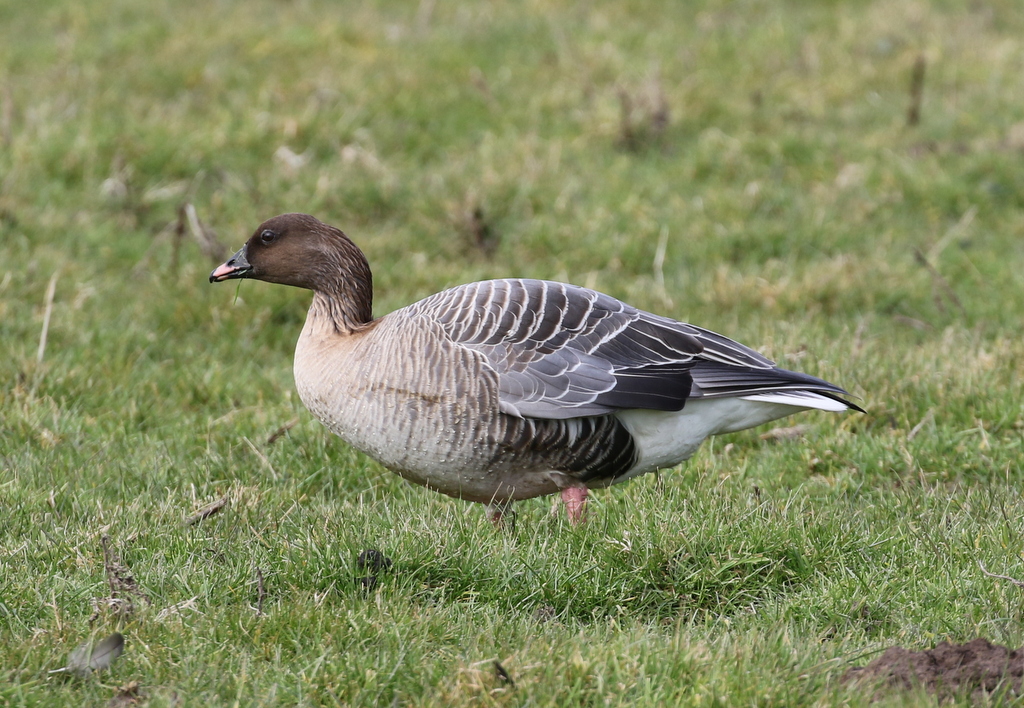
Out on the saltmarsh the other side, we made our way east. It was fairly quiet out here today, so we headed straight towards the Shorelarks favourite spot. While we were still some way off, we could see a couple standing sensibly on the edge of the saltmarsh and three photographers right out in the middle. We saw the photographers look up, scan round and then go charging across to the other side. As they stopped again, we noticed nine small birds flying away, disappearing off towards Wells. They had flushed the Shorelarks!
Thankfully, by the time we had walked out to join the couple – who were none too impressed with the behaviour of the photographers either – six Shorelarks had flown back in and landed down on the saltmarsh well away from their pursuers. We stood and watched them from a discrete distance – admiring their yellow faces and black bandit masks.
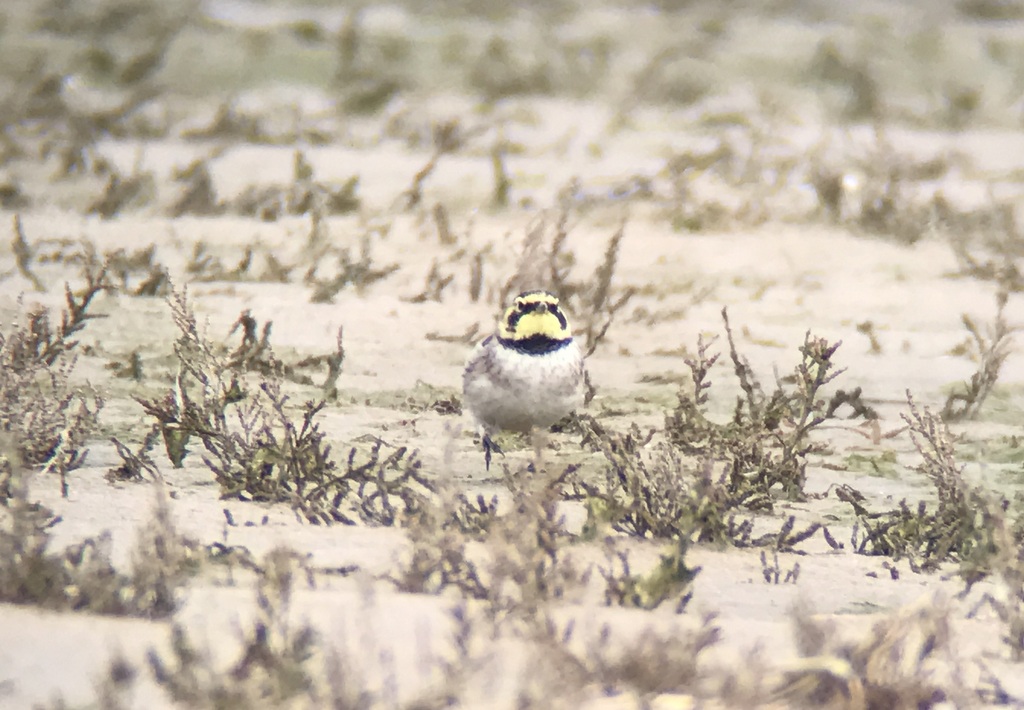
Woodcock was another species on the list, but they can be very tricky to find during the day. We made our way back to the car via the pines. It was generally very quiet in the trees, although we did come across a tit flock – Long-tailed Tits, Coal Tits and a Treecreeper. We did manage to find a Woodcock, but it flew up from underneath a tree before we got anywhere near it and all we saw of it was a large rusty brown shape disappearing off through the pines.
At that stake, we noticed a missed call and then several messages to say that a Snowy Owl had been seen just along the coast at Scolt Head. Thankfully, we were almost back at the car and it was not very far away, so we got round there very quickly, before the crowds arrived. We could see a couple of people out on the saltmarsh as we walked out and they helpfully called us to say we would be best viewing from up on the seawall.
It was very easy to spot the Snowy Owl as it was being mobbed by two Red Kites, which were flying round and diving down at it repeatedly. We could see an enormous greyish-white bird on the ground beneath them. This was definitely not a species which was on the list, but only because it is so unusual here that it wasn’t even considered as a possibility! The last record of one in Norfolk was back in March 1991.
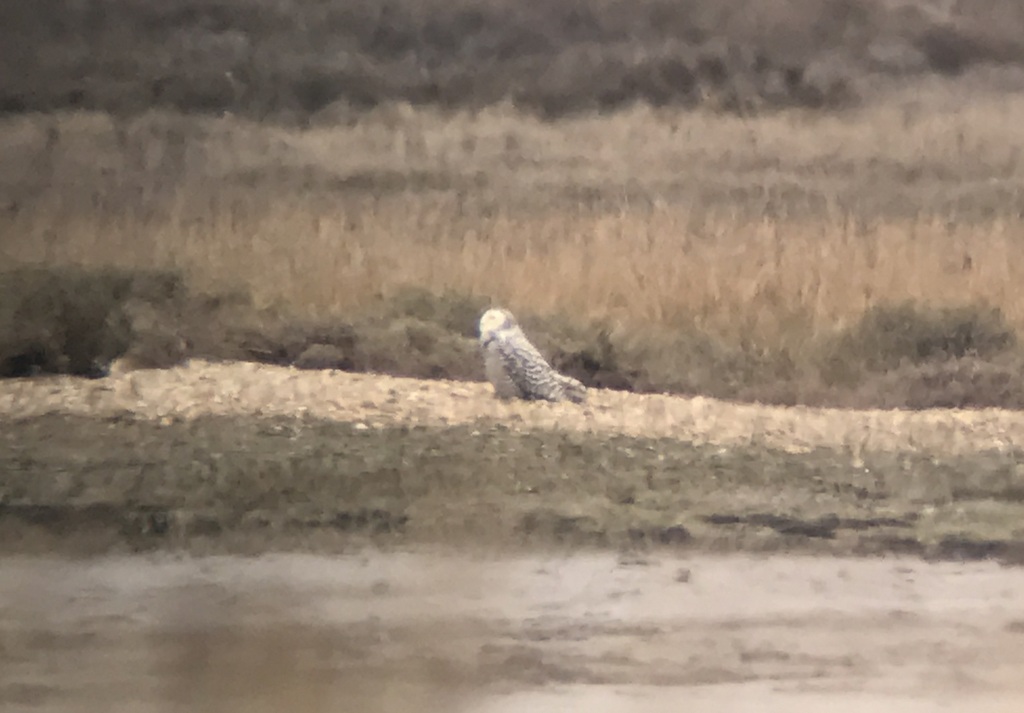
The Snowy Owl was quite a dark bird, possibly a young female, heavily marked with thick black bars above and finer bars below, on a white background. The face was more contrasting white. It sat on a shingle beach on the edge of Scolt Head Island, looking round. We joined the others out on the saltmarsh and had a great view of it through the scope.
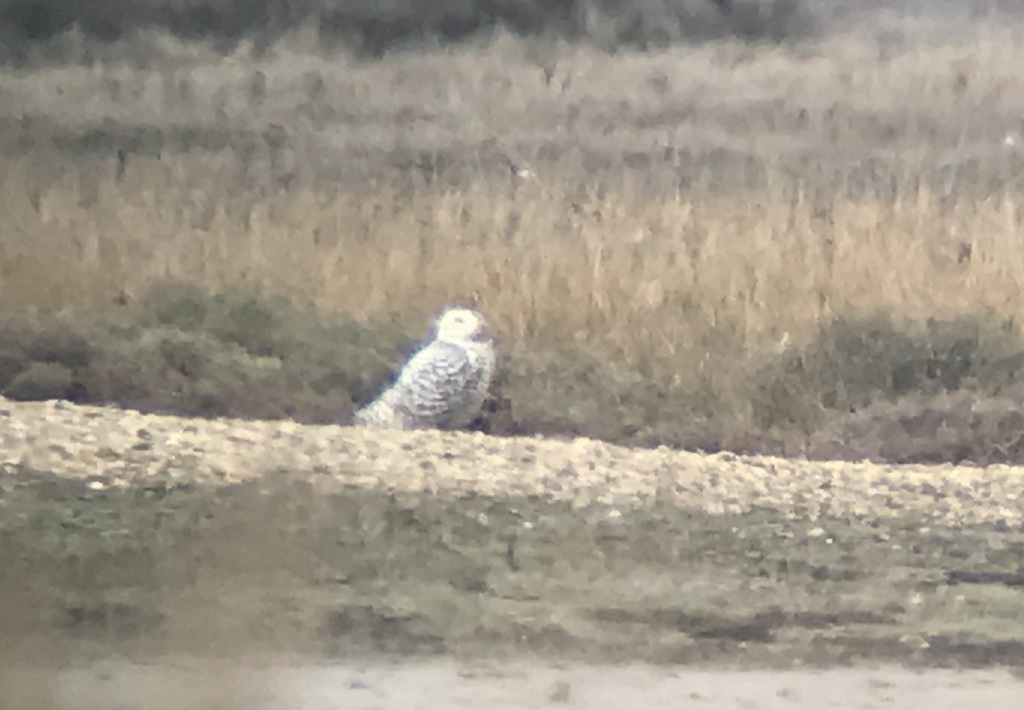
Having watched the Snowy Owl for a while, enthralled, we decided we should move on and try to see something else before the end of the day. We headed round to Titchwell. As we walked down the path towards the visitor centre, a smart male Brambling appeared in the sallows nearby. Another one from the target list.
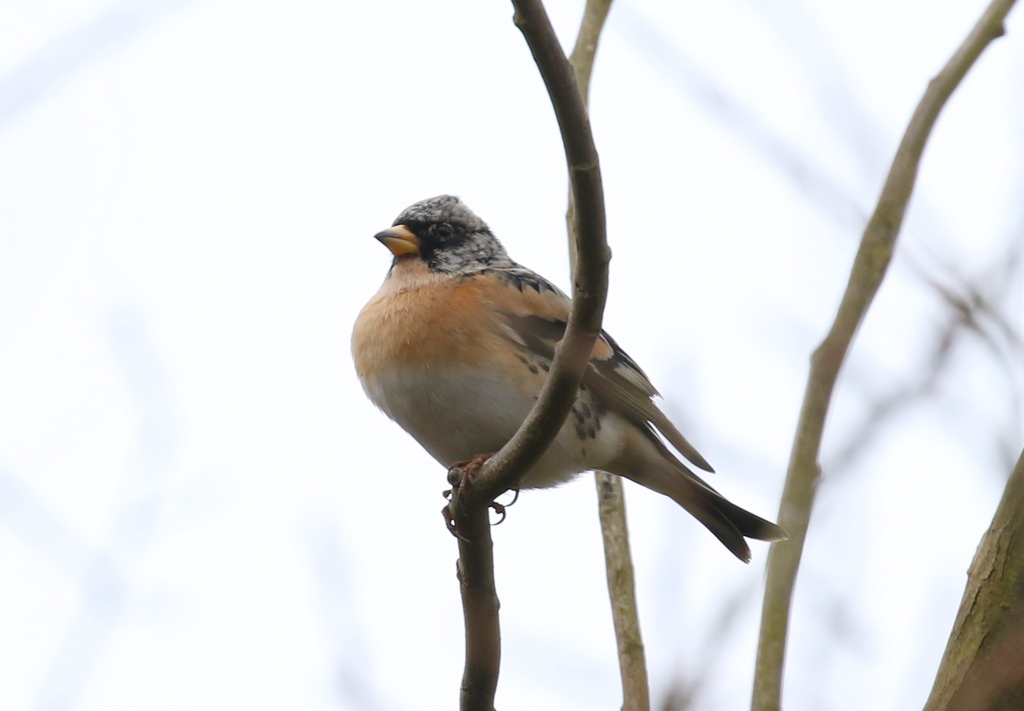
There were not so many birds on the feeders in front of the visitor centre, and just Chaffinches and Greenfinches on the ones the other side. We headed straight out onto the reserve. The Thornham grazing marsh ‘pool’ was very quiet – no sign of any Water Pipits. The reedbed pool had Tufted Duck and more Common Pochard. As we stood and scanned, a Marsh Harrier was quartering over the reeds and a Barn Owl was out hunting along the bank at the back.
The water level on the freshmarsh remains quite high, so there were few birds of note here today. The one thing of interest is the number of Mediterranean Gulls which are now back on the reserve. Several pairs flew back and forth calling and we could see at least 15 with the Black-headed Gulls on the fenced off island.
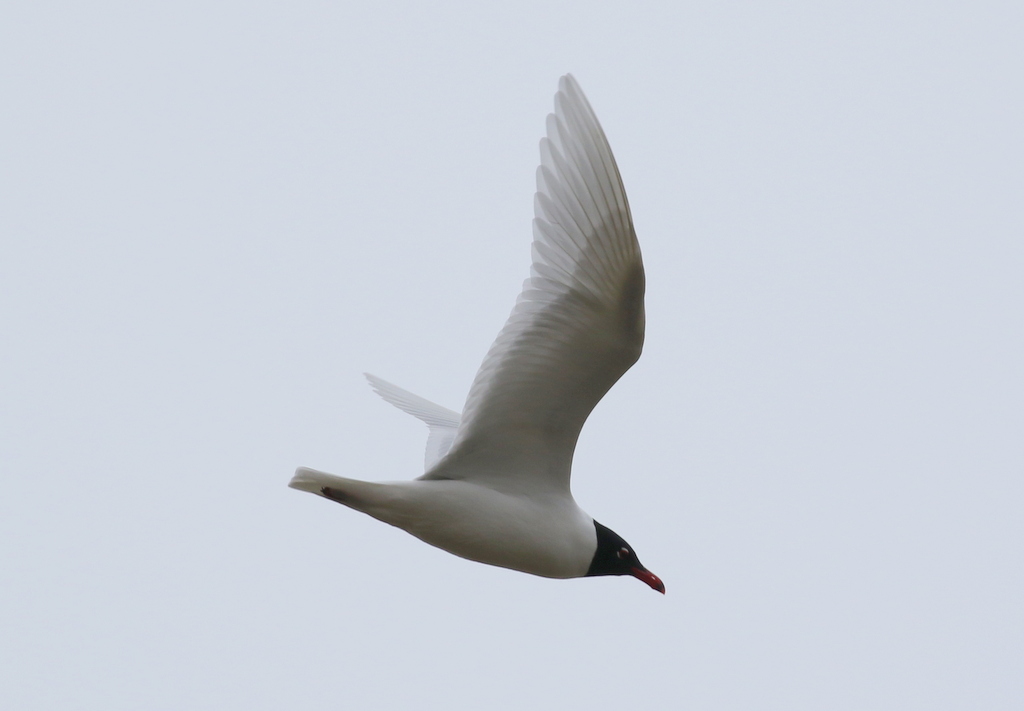
There were a few waders on the Volunteer Marsh – Curlew, Black-tailed Godwit, Redshanks and several Avocets. A big flock of Linnets flew up from the islands of vegetation. There was a lot of water on the Tidal Pools too and not much on here either, apart from a few Gadwall and a Little Grebe.
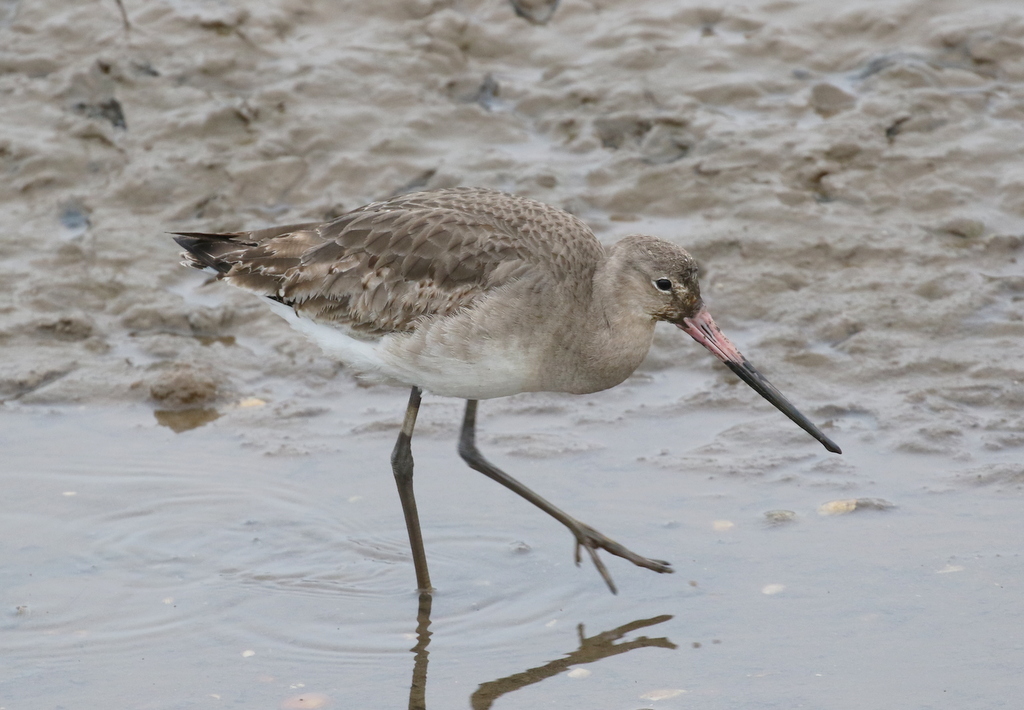
What we had really come here to look for though was out on the sea, so we made our way quickly out onto the beach. It didn’t take long to locate our target – three Long-tailed Ducks out on the water. They were rather distant at first, but a little while later we found them much closer, at least 14 of them now, and we could see the long tails on several of the drakes.
There were other ducks out here too – the headline being a flock of six (Greater) Scaup, plus several Red-breasted Merganser and Goldeneye and a small number of Common Scoter. There were plenty of Great Crested Grebes offshore too. Looking down along the shore, we added Bar-tailed Godwit to the list and had a better look at a Sanderling.
With everyone suitably exhausted after such a mammoth day along the coast, we made our way back. A Sparrowhawk flashed past across the saltmarsh and disappeared out over the reeds. The light was already starting to go as we headed for home, but what an amazing day it had been.
















